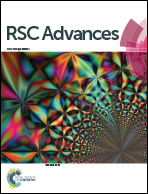Highly responsive glutathione functionalized green AuNP probe for precise colorimetric detection of Cd2+ contamination in the environment†
Abstract
AuNPs phytosynthesized using the aqueous leaf extract of Rosa indica – wichuriana hybrid Francois guillot showed a well-defined surface plasmon band centered at around 520 nm which is the characteristic of gold nanoparticles. HRTEM micrographs showed that the sizes of the AuNPs were in the range of 5–13 nm. The AuNPs were functionalized using glutathione via the thiol group from the cysteine moiety to develop a highly responsive GSH-AuNP probe for precise colorimetric detection of Cd2+. The functionalization was confirmed by FT-IR. Atomic absorption spectroscopy was used to quantify the heavy metals present in the two water samples collected from the water bodies in Ranipet, a suburban town and industrial hub of Vellore city in the state of Tamil Nadu in southern India. The colorimetric selectivity of the GSH-AuNP probe to the quantified metal ions Mg2+, Ca2+, Ba2+, Ni2+, Mn2+, Cu2+, Hg2+, Co2+, Cd2+, Cr3+, Fe2+ was ascertained by UV-Vis spectroscopy. The observations demonstrate that only Cd2+ stimulated the GSH-AuNPs solution to turn from ruby red to purple and resulted in a substantial shift in the SP band to a longer wavelength of 594 nm owing to GSH-AuNPs aggregation. The minimum and maximum detection limit of Cd2+ by the GSH-AuNP probe was inferred to be 30–70 nM (3 × 10−8 M and 7 × 10−8 M) respectively. The feasibility of employing the probe practically in the environment to detect Cd2+ was demonstrated using two water samples. The aggregation-based change in color from ruby red to purple occurred in less than 10 min. This result could be considered a straight forward and instantaneous detection of Cd2+ devoid of any interference from other metal ions that were present in the water samples.


 Please wait while we load your content...
Please wait while we load your content...